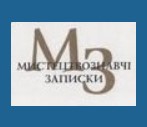НІМЕЦЬКИЙ ІНСТРУМЕНТАЛІЗМ XVIII СТОРІЧЧЯ В ПЕРЕТИНІ ІЗ ПОСТАВАНГАРДНИМИ НАДБАННЯМИ СЬОГОДЕННЯ
GERMAN INSTRUMENTALISM OF THE EIGHTEENTH CENTURY IN INTERSECTION WITH THE POST-AVANT-GARDE HERITAGE OF THE PRESENT
Author(s): Vasyl BabukhivskyiSubject(s): Museology & Heritage Studies, Music, 18th Century, History of Art
Published by: Національна академія керівних кадрів культури і мистецтв
Keywords: instrumental music; German style in music; style of the era; baroque; classicism; post-avant-garde;
Summary/Abstract: The purpose of this article is a stylistic analysis of the musical and artistic tendencies of eighteenth-century German music, in which not only the antitheses of the respective typological achievements, but also their certain diffuse vagueness, their connection with the political background of the convergence of confessional divisions, with a complex interweaving of religious and national-social factors – constituted the fertile ground for creative discoveries correlated with the "disappearance of trends" in post-avant-garde music. The research methodology is the intonation approach, as it was mentioned in the works of B. Asaf'ev's followers in Ukraine (see publications of D. Androsova, O. Markova, O. Muravska), as well as based on the development of the instrumental performance of the Odessa school (works by Z Bukatskyi, K. Mülberg). The scientific novelty of the work is noted in the originality of the presentation of the meaning of the stylistic diffusions of instrumental art of this era and the basic understanding of the ecclesiastical expressive component in them, which provided and provides an independent stylistic flavour with appropriate typological combinations, correlated with the playful mosaicism of post-avant-garde and post-post-avant-garde of the present. Conclusions. The stylistic eclecticism of the Baroque and Early Classical period of German art is based, firstly, on the religious and applied inseparability of the principles of Italian and German instrumentalism of the eighteenth century against the background of the existence of the German cultural idea and the coexistence of national traditions with it and the inertia of the latter’s unity in cultural use. And, secondly, the lack of expression German presence in opera until the 1780s, in which the antithetical positions of the styles were concentrated, stimulated typological intersections in instrumentalism, evaluated in their artistic significance of playful concertos in the post-avant-garde existence.
Journal: Мистецтвознавчі записки
- Issue Year: 2023
- Issue No: 43
- Page Range: 157-162
- Page Count: 6
- Language: Ukrainian

